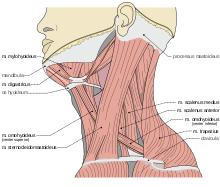User:Mr. Ibrahem/Cervical dystonia
| Cervical dystonia | |
|---|---|
| Other names | Spasmodic torticollis, spasmodic wryneck |
 | |
| Muscles of the neck | |
| Symptoms | Abnormal twisted position of the neck, pain[1] |
| Complications | Arthritis of the neck[2] |
| Usual onset | 40 to 60 years old[2] |
| Types | Primary, secondary[1] |
| Causes | Unknown, genetic mutation, brain injury, viral encephalitis high thyroid, Wilson disease, Huntington disease, kernicterus[1] |
| Diagnostic method | Based on symptoms[2] |
| Treatment | Anticholinergics, benzodiazepines, baclofen, botulinum toxin, deep brain stimulation[1] |
| Frequency | 1 in 10,000 per year[1] |
Cervical dystonia, also known as spasmodic torticollis, is when muscle spasms of the neck results in the head being twisted.[1] Typically this results in the head being tilted towards one shoulder with the chin turned towards the other.[1] Pain is often present and the condition may last months or years.[1][3] It generally resolves during sleep.[1] Complications may include arthritis of the neck.[2]
The cause in most cases is unknown.[1] Some develop the disorder as a result of an injury, medication use, genetic mutation, brain injury, viral encephalitis high thyroid, Wilson disease, Huntington disease, or kernicterus.[1][4] Onset may be days to months after an injury.[4] The underlying mechanism generally involves spasms of the sternocleidomastoid.[1] Diagnosis is based on symptoms.[2]
Cervical dystonia may be treated with anticholinergics, benzodiazepines, baclofen, botulinum toxin, or deep brain stimulation.[1] About 1 in 10,000 are affected per year.[1] The neck is one of the most common locations affected by dystonia.[4] Onset is often around the age of 40 to 60.[2] Women are more commonly affected than men.[2]
References[edit]
- ^ a b c d e f g h i j k l m n Tomczak, KK; Rosman, NP (March 2013). "Torticollis". Journal of child neurology. 28 (3): 365–78. doi:10.1177/0883073812469294. PMID 23271760.
- ^ a b c d e f g "Cervical Dystonia". NORD (National Organization for Rare Disorders). Archived from the original on 6 March 2021. Retrieved 6 March 2021.
- ^ "Dystonias Fact Sheet | National Institute of Neurological Disorders and Stroke". www.ninds.nih.gov. Archived from the original on 23 April 2018. Retrieved 6 March 2021.
- ^ a b c Cunha, B; Tadi, P; Bragg, BN (January 2021). "Torticollis". PMID 30969679.
{{cite journal}}: Cite journal requires|journal=(help)
